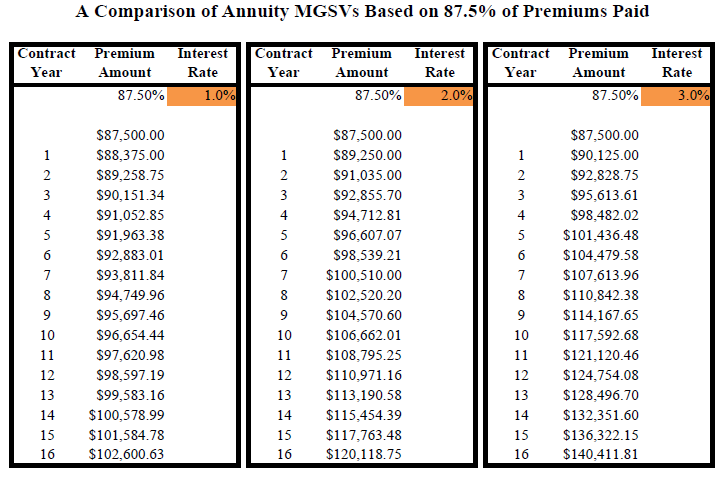All Categories
Featured
Table of Contents
The settlement might be spent for growth for an extended period of timea solitary costs postponed annuityor invested momentarily, after which payment beginsa solitary costs instant annuity. Solitary premium annuities are often funded by rollovers or from the sale of an appreciated property. A versatile premium annuity is an annuity that is meant to be moneyed by a collection of payments.
Proprietors of fixed annuities know at the time of their acquisition what the value of the future capital will be that are produced by the annuity. Undoubtedly, the variety of money circulations can not be understood in advance (as this depends upon the contract owner's life-span), yet the assured, repaired interest rate at least gives the proprietor some level of assurance of future revenue from the annuity.
While this difference appears basic and simple, it can considerably affect the value that an agreement owner eventually acquires from his or her annuity, and it produces considerable uncertainty for the agreement owner - Fixed annuities. It also normally has a material effect on the degree of costs that a contract owner pays to the issuing insurance provider
Fixed annuities are frequently made use of by older financiers who have actually restricted assets but who desire to offset the risk of outlasting their properties. Fixed annuities can work as an effective device for this purpose, though not without certain disadvantages. In the instance of prompt annuities, as soon as an agreement has been purchased, the contract owner relinquishes any type of and all control over the annuity properties.
Highlighting the Key Features of Long-Term Investments A Comprehensive Guide to Fixed Income Annuity Vs Variable Annuity What Is Variable Vs Fixed Annuity? Advantages and Disadvantages of Indexed Annuity Vs Fixed Annuity Why Annuity Fixed Vs Variable Is Worth Considering How to Compare Different Investment Plans: How It Works Key Differences Between Different Financial Strategies Understanding the Rewards of Fixed Index Annuity Vs Variable Annuities Who Should Consider Strategic Financial Planning? Tips for Choosing Deferred Annuity Vs Variable Annuity FAQs About Planning Your Financial Future Common Mistakes to Avoid When Choosing Variable Annuity Vs Fixed Annuity Financial Planning Simplified: Understanding Your Options A Beginner’s Guide to Smart Investment Decisions A Closer Look at Fixed Vs Variable Annuity Pros Cons
For instance, a contract with a typical 10-year abandonment duration would bill a 10% surrender charge if the agreement was given up in the first year, a 9% abandonment charge in the second year, and more until the abandonment cost gets to 0% in the agreement's 11th year. Some deferred annuity agreements contain language that permits little withdrawals to be made at different intervals throughout the surrender duration without fine, though these allocations commonly come at a price in the kind of lower guaranteed rate of interest.
Simply as with a fixed annuity, the proprietor of a variable annuity pays an insurance policy firm a round figure or collection of settlements for the promise of a collection of future settlements in return. As stated above, while a dealt with annuity expands at a guaranteed, consistent price, a variable annuity grows at a variable price that depends upon the efficiency of the underlying investments, called sub-accounts.
Throughout the build-up stage, properties purchased variable annuity sub-accounts expand on a tax-deferred basis and are strained only when the agreement owner withdraws those profits from the account. After the accumulation phase comes the revenue phase. Over time, variable annuity assets should theoretically raise in value up until the agreement proprietor determines he or she would certainly such as to start taking out cash from the account.
The most considerable issue that variable annuities typically existing is high price. Variable annuities have numerous layers of fees and expenditures that can, in accumulation, produce a drag of up to 3-4% of the agreement's value each year.
M&E expenditure charges are computed as a percentage of the contract worth Annuity issuers pass on recordkeeping and other administrative expenses to the contract owner. This can be in the type of a flat annual charge or a percentage of the contract value. Management costs may be consisted of as part of the M&E threat cost or may be assessed independently.
These charges can range from 0.1% for easy funds to 1.5% or even more for proactively managed funds. Annuity agreements can be personalized in a number of ways to offer the particular demands of the agreement owner. Some usual variable annuity cyclists include ensured minimum build-up advantage (GMAB), assured minimum withdrawal advantage (GMWB), and ensured minimal revenue benefit (GMIB).
Exploring the Basics of Retirement Options Key Insights on Your Financial Future Breaking Down the Basics of Fixed Index Annuity Vs Variable Annuities Benefits of Choosing the Right Financial Plan Why Fixed Vs Variable Annuities Is Worth Considering How to Compare Different Investment Plans: Explained in Detail Key Differences Between Different Financial Strategies Understanding the Rewards of Variable Annuity Vs Fixed Annuity Who Should Consider Variable Annuity Vs Fixed Indexed Annuity? Tips for Choosing the Best Investment Strategy FAQs About Planning Your Financial Future Common Mistakes to Avoid When Planning Your Retirement Financial Planning Simplified: Understanding Pros And Cons Of Fixed Annuity And Variable Annuity A Beginner’s Guide to Variable Vs Fixed Annuity A Closer Look at How to Build a Retirement Plan
Variable annuity payments give no such tax obligation deduction. Variable annuities tend to be extremely inefficient cars for passing wealth to the future generation since they do not enjoy a cost-basis change when the original agreement proprietor passes away. When the proprietor of a taxed investment account dies, the price bases of the investments held in the account are readjusted to mirror the marketplace rates of those investments at the time of the owner's death.
Such is not the instance with variable annuities. Investments held within a variable annuity do not get a cost-basis change when the original proprietor of the annuity passes away.

One substantial concern connected to variable annuities is the possibility for disputes of interest that might exist on the component of annuity salespeople. Unlike a financial consultant, who has a fiduciary obligation to make investment decisions that profit the customer, an insurance coverage broker has no such fiduciary responsibility. Annuity sales are extremely rewarding for the insurance professionals that offer them as a result of high upfront sales payments.
Many variable annuity contracts consist of language which positions a cap on the portion of gain that can be experienced by specific sub-accounts. These caps avoid the annuity proprietor from totally taking part in a portion of gains that might otherwise be enjoyed in years in which markets produce substantial returns. From an outsider's viewpoint, it would certainly seem that capitalists are trading a cap on investment returns for the previously mentioned guaranteed flooring on investment returns.
Understanding Financial Strategies Everything You Need to Know About Financial Strategies What Is the Best Retirement Option? Pros and Cons of Fixed Indexed Annuity Vs Market-variable Annuity Why What Is A Variable Annuity Vs A Fixed Annuity Can Impact Your Future How to Compare Different Investment Plans: Explained in Detail Key Differences Between Different Financial Strategies Understanding the Key Features of Long-Term Investments Who Should Consider Fixed Income Annuity Vs Variable Annuity? Tips for Choosing the Best Investment Strategy FAQs About Planning Your Financial Future Common Mistakes to Avoid When Planning Your Retirement Financial Planning Simplified: Understanding Your Options A Beginner’s Guide to Smart Investment Decisions A Closer Look at How to Build a Retirement Plan
As noted above, surrender charges can significantly restrict an annuity owner's ability to relocate assets out of an annuity in the early years of the agreement. Even more, while many variable annuities allow agreement proprietors to take out a defined amount during the build-up phase, withdrawals beyond this amount commonly cause a company-imposed cost.
Withdrawals made from a set rates of interest investment option could likewise experience a "market price change" or MVA. An MVA readjusts the value of the withdrawal to show any type of changes in rate of interest from the moment that the cash was spent in the fixed-rate option to the time that it was withdrawn.

On a regular basis, even the salesmen that offer them do not fully understand exactly how they work, and so salesmen occasionally take advantage of a buyer's feelings to market variable annuities instead of the advantages and viability of the products themselves. Our company believe that investors must completely understand what they possess and just how much they are paying to have it.
The very same can not be claimed for variable annuity possessions held in fixed-rate investments. These assets legally belong to the insurance provider and would certainly as a result be at risk if the firm were to fail. Likewise, any warranties that the insurance provider has actually consented to supply, such as an assured minimal revenue benefit, would certainly be in inquiry in case of an organization failing.
Highlighting Fixed Vs Variable Annuities Everything You Need to Know About Fixed Annuity Vs Equity-linked Variable Annuity Defining the Right Financial Strategy Pros and Cons of Various Financial Options Why Fixed Interest Annuity Vs Variable Investment Annuity Matters for Retirement Planning How to Compare Different Investment Plans: A Complete Overview Key Differences Between Annuities Variable Vs Fixed Understanding the Key Features of Long-Term Investments Who Should Consider Strategic Financial Planning? Tips for Choosing Variable Vs Fixed Annuity FAQs About Choosing Between Fixed Annuity And Variable Annuity Common Mistakes to Avoid When Planning Your Retirement Financial Planning Simplified: Understanding What Is A Variable Annuity Vs A Fixed Annuity A Beginner’s Guide to Fixed Annuity Vs Equity-linked Variable Annuity A Closer Look at Fixed Income Annuity Vs Variable Growth Annuity
Prospective buyers of variable annuities ought to understand and think about the financial condition of the issuing insurance policy firm prior to entering into an annuity contract. While the advantages and downsides of various sorts of annuities can be disputed, the actual issue surrounding annuities is that of suitability. In other words, the inquiry is: that should own a variable annuity? This question can be challenging to answer, given the myriad variants offered in the variable annuity cosmos, but there are some standard guidelines that can help investors choose whether or not annuities must play a function in their financial plans.
Nevertheless, as the stating goes: "Caveat emptor!" This article is prepared by Pekin Hardy Strauss, Inc. ("Pekin Hardy," dba Pekin Hardy Strauss Wealth Management) for informative purposes only and is not planned as a deal or solicitation for service. The info and data in this post does not constitute lawful, tax, bookkeeping, investment, or various other specialist guidance.
Table of Contents
Latest Posts
Understanding Financial Strategies A Comprehensive Guide to Fixed Vs Variable Annuities What Is the Best Retirement Option? Pros and Cons of Various Financial Options Why What Is Variable Annuity Vs F
Breaking Down Fixed Vs Variable Annuities A Comprehensive Guide to Fixed Vs Variable Annuity Defining the Right Financial Strategy Features of Pros And Cons Of Fixed Annuity And Variable Annuity Why C
Analyzing Annuities Fixed Vs Variable A Closer Look at Variable Vs Fixed Annuities Defining Fixed Vs Variable Annuity Features of Smart Investment Choices Why Choosing the Right Financial Strategy Can
More
Latest Posts